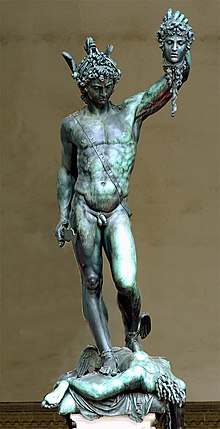Medusa
Medusa is a character in Greek mythology. Her story has been told and retold by ancient and modern storytellers, writers, and artists.


The Latin poet Ovid writes in Book IV of his Metamorphoses that Poseidon had raped Medusa in the temple of Athena.[1] The goddess was angry, and changed Medusa into a monster with snakes for hair. To people in Ovid's time, Medusa, not Poseidon, was the one who had done something wrong.
Artists have made statues and paintings of Medusa for thousands of years. Ancient Greeks and other ancient people painted Medusa's face on pots and doors and other things. In Greek art from this time, artists usually painted or carved people looking out to the side. Medusa was almost always carved looking out of the picture toward the viewer. This was so Medusa could scare evil things away. These pictures of Medusa are called Gorgoneions. They are an example of using one evil thing to make other evil things leave, the same way Perseus used Medusa against his other enemies.[1]
Myth
changeMedusa was one of three sisters, the Gorgons. Medusa's sisters were Stheno and Euryale. Medusa was mortal, but her sisters were immortal. They were all children of the sea gods, Phorkys and his sister Keto. Before they were monsters, all three sisters were beautiful young women, Medusa the most; however, she was a priestess in the temple of Athena and was bound by a vow of celibacy.
Any man or animal who looked directly upon her was turned to stone.
The hero Perseus cut off Medusa's head. He snuck up on her by using his shiny shield as a mirror. He put Medusa's head in a special bag and then showed it to his enemies. They turned to stone. Then he gave Medusa's head to the gods. Either Zeus or Athena put her head on the shield called aegis.
Medusa was pregnant by Poseidon at the time of her death. Pegasus, a winged horse, and Chrysaor, a golden giant, sprang from her blood.
Medusa in art
changeMedusa was a subject for ancient vase painters, mosaicists, and sculptors. She appears on the breastplate of Alexander the Great in the Alexander Mosaic at the House of the Faun in Pompeii, Italy (about 200 BC).
A Roman copy of Phidias' Medusa (left) is held in the Glyptothek in Munich, Germany.
Among the Renaissance depictions are the sculpture Perseus with the Head of Medusa by Benvenuto Cellini (1554) and the oil painting Medusa by Caravaggio (1597).
Baroque depictions include Head of Medusa by Peter Paul Rubens (1618); the marble bust Medusa by Bernini (1630s); and Perseus Turning Phineus and his Followers to Stone, an oil painting by Luca Giordano from the (early 1680s).
Romantic and modern depictions include Perseus with the Head of Medusa by Antonio Canova (1801) and Perseus, a sculpture by Salvador Dalí. Twentieth century artists whno tackled the Medusa theme include Paul Klee, John Singer Sargent, Pablo Picasso, Pierre et Gilles, and Auguste Rodin. The twenty-first century sculpture Medusa with the Head of Perseus by Luciano Garbati became part of the #MeToo Movement.[2][3]
References
change- ↑ 1.0 1.1 Madeleine Glennon (2017). "Medusa in Ancient Greek Art". Heilbrunn Timeline of Art History. Metropolitan Museum of Art. Retrieved September 9, 2021.
- ↑ Julia Jacobs (October 13, 2020). "How a Medusa Sculpture From a Decade Ago Became #MeToo Art". New York Times. Retrieved September 9, 2021.
- ↑ Annaliese Griffin (December 2, 2018). "The story behind the Medusa statue that has become the perfect avatar for women's rage". QZ. Retrieved September 9, 2021.